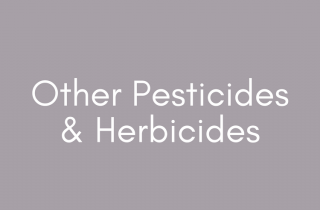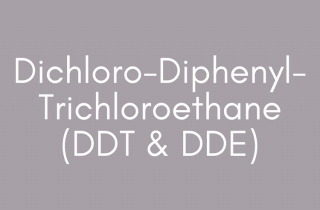Glyphosate-based Herbicides
At a Glance
Glyphosate is a synthetic hormone-disrupting compound chemical widely used in herbicides, most notoriously in Monsanto’s Roundup. In fact, glyphosate-based herbicides (GBHs) are the most widely used herbicides globally.
Glyphosate exposures during critical periods of breast development (e.g., gestation, early childhood, adolescence, pregnancy) may lead to later risk for developing breast cancer.
What is glyphosate?
Glyphosate is a synthetic compound discovered in 1950 and first formulated in 1974 in a commercial herbicide produced and sold by Monsanto as Roundup. Because Roundup actually killed all vegetation on which it was sprayed, its initial applications were limited to rights of way, pipeline areas, between-row cultivation areas, etc. Following Monsanto’s pairing of Roundup with genetically-modified herbicide (glyphosate)-resistant soybean, maize and cotton seeds in the mid 1990’s, the herbicide’s agricultural use has exploded.
Glyphosate has been shown to be an endocrine disrupting compound, acting mainly through interactions with the estrogen receptor.[1],[2]
What are glyphosate-based herbicides (GBHs)?
Glyphosate-based herbicides (GBHs) are the most widely used herbicides globally. Although Monsanto lost its patent protection for Roundup in 2000, leading to numerous other globally positioned companies to make and sell other glyphosate-based herbicides (GBHs), Monsanto remains the major producer of GBHs through its bundling of Roundup and the herbicide-resistant seeds.[3]
Where are glyphosate-based herbicides (GBHs) found?
Glyphosate and its major breakdown product, aminomethylphosphonic acid (AMPA), are found in soil, air and water, but at levels that are considered by several global regulatory agencies to be below the ‘Acceptable Daily Intake’ levels.[4] Glyphosate is also found in the urine of humans, including in both those exposed occupationally (agricultural workers, sprayers) and those exposed in the more general population.[5] Glyphosate has been detected in the urine samples from rural pregnant women in the U.S.[6]
What evidence links GBH exposures to breast cancer?
In 2015 the International Agency for Research on Cancer (IARC) classified glyphosate as a ‘probable human carcinogen’.[7] However, in 2016 the U.S. EPA concluded that glyphosate is ‘not likely to be carcinogenic to humans’, based primarily on studies of non-occupational exposures.[8],[9]
In addition to containing high proportions of the active herbicidal ingredient glyphosate, GBHs also contain numerous other ingredients which may interact with glyphosate or have physiological effects of their own.
A 2021 study examined urinary AMPA levels and later development of breast cancer in Hawaiian women participating in the Multiethnic Cohort Study. AMPA was detected in most urine samples tested, although it was found in significantly more samples from women who went on to develop breast cancer in the next 10-15 years than in long-term healthy women. After adjusting for factors including race/ethnicity, age, and body mass index (BMI; a measure of relative obesity), there was a 4.5-fold increase in risk for developing breast cancer in women with the highest, vs the lowest, concentrations of urinary AMPA.[10]
In animal studies, exposure of young, postnatal male rats to low doses of GBHs led to changes in the mammary gland at the time of weaning. By early adulthood, these exposures were associated with further changes indicating an increased risk for developing mammary tumors.[11] Low dose exposure of GBH to postnatal female rats led to long term changes in mammary gland structure in adulthood. These changes included an increase in the percent of mammary ductal cells with hyperplasia (increased proliferation) as well as morphological changes indicative of a pre-cancer state.[12]
While unfortunately this study did not look at mammary gland outcomes, the exposure of pregnant rats to GBH led to reproductive problems in the daughter pups of those pregnant dams, and structural congenital anomalies, delayed fetal growth and increased placental weight in the granddaughters (F2 generation) of the dams, even though the daughters were only exposed to GBHs during gestation.[13] Whether these transgenerational effects would be found in altered mammary gland structure and function, as well as risk for tumor development, remains to be studied.
Exposure of hormone receptor positive (ER+) human breast cells (MCF-7) in culture to commercial GBHs led to an increase in estrogen-induced cell proliferation. On the other hand, additives found in addition to glyphosate in commercial GBH formulations, did not activate the estrogen pathways in the MCF-7 cells.[14]
In another series of studies using cultured breast cancer cells, short term exposures of very low doses of GBH (Roundup) led to disruption of the cell cycle and DNA repair mechanisms in both estrogen receptor positive (MCF-7) and estrogen receptor negative (MDA-MB-468) cells.[15] Thus while glyphosate, alone, leads to increases in cell proliferation in this laboratory model, use of GBHs containing both the glyphosate and the additives found in Roundup, leads to cell death.
Who is most likely to be exposed to GBHs?
National Health and Nutrition Examination Survey (NHANES) released 2022 data demonstrating the ubiquitous presence glyphosate in human urine samples from across the country.[20] More localized studies studies indicate that agricultural workers who are exposed to GBHs, and their family members have significant body burdens of the chemicals, as do people who live in the general area where crops are sprayed. For people living in comparable areas, children have higher levels than do adults.[16] A few studies have found measurable levels in urine sample from non-occupationally exposed people, including pregnant women.[17]
Who is most vulnerable to the health effects of GBHs?
Anyone exposed to glyphosate-based herbicides is susceptible to the endocrine-disrupting effects of the chemical. Glyphosate acts through estrogenic pathways suggesting that exposures during critical periods of breast development (e.g., gestation, early childhood, adolescence, pregnancy) may lead to deleterious effects on later risk for developing breast cancer.
What are the top tips to avoid exposure to glyphosate-based herbicides?
- If outside in agricultural areas, wear fitted protective clothing including long sleeves, pants, boots, gloves and masks when exposed to pesticides containing toxic chemicals. Clothing made of synthetic material is more resistant to penetration by herbicides, and non-organic cotton may be contaminated by glyphosate.[18],[19]
- Wash produce well before eating. Where possible, buy USDA certified organic produce, which has not been treated with pesticides or herbicides. This includes oats, soy and other beans, in addition to fruits and vegetables.
Updated 2021
[1] Thongprakasiang, Siriporn et al. “Glyphosate induces human breast cancer cells growth via estrogen receptors.” Food and Chemical Toxicology 59 (2013): 129-136. doi:10.1016/j.fct.2013.05.057.
[2] Zanardi, María V et al. “Glyphosate-based herbicide induces hyperplastic ducts in the mammary gland of aging Wistar rats.” Molecular and Cellular Endocrinology 501 (2020): 110658. doi:10.1016/j.mce.2019.110658.
[3] Benbrook, Charles M. “Trends in glyphosate herbicide use in the United States and globally.” Environmental Sciences Europe 28,1 (2016): 3. doi:10.1186/s12302-016-0070-0.
[4] Benbrook, Charles M. “Trends in glyphosate herbicide use in the United States and globally.” Environmental Sciences Europe 28,1 (2016): 3. doi:10.1186/s12302-016-0070-0.
[5] Gillezeau, Christina et al. “The evidence of human exposure to glyphosate: a review.” Environmental Health: A Global Access Science Source 18,1 (2019): 2. doi:10.1186/s12940-018-0435-5.
[6] Parvez, S et al. “Glyphosate exposure in pregnancy and shortened gestational length: a prospective Indiana birth cohort study.” Environmental Health: A Global Access Science Source 17,1 (2018): 23. doi:10.1186/s12940-018-0367-0.
[7] IARC Monographs on the Evaluation of Carcinogenic Risks to Humans Volume 112. “Some Organophosphate Insecticides and Herbicides.” 2017. http://monographs.iarc.fr/ENG/Monographs/vol112/mono112-10.pdf. Accessed 18 Nov 2020.
[8] Benbrook, Charles M. “Trends in glyphosate herbicide use in the United States and globally.” Environmental Sciences Europe 28,1 (2016): 3. doi:10.1186/s12302-016-0070-0.
[9] Zanardi, María V et al. “Glyphosate-based herbicide induces hyperplastic ducts in the mammary gland of aging Wistar rats.” Molecular and Cellular Endocrinology 501 (2020): 110658. doi:10.1016/j.mce.2019.110658.
[10] Franke, Adrian A et al. “Pilot study on the urinary excretion of the glyphosate metabolite aminomethylphosphonic acid and breast cancer risk: The Multiethnic Cohort study.” Environmental Pollution 277 (2021): 116848. doi:10.1016/j.envpol.2021.116848.
[11] Altamirano, Gabriela A. et al. “Postnatal exposure to a glyphosate-based herbicide modifies mammary gland growth and development in Wistar male rats.” Food and Chemical Toxicology 118 (2018): 111-118. doi:10.1016/j.fct.2018.05.011.
[12] Zanardi, María V et al. “Glyphosate-based herbicide induces hyperplastic ducts in the mammary gland of aging Wistar rats.” Molecular and Cellular Endocrinology 501 (2020): 110658. doi:10.1016/j.mce.2019.110658.
[13] Milesi et al. “Perinatal exposure to a gylphosate-based herbicide impairs female reproductive outcomes and induces second-generation adverse effects in Wistar rats.” Reproductive Toxicology 92 (2018): 2629-2643. doi:10.1007/s00204-018-2236-6.
[14] Mesnage, Robin, et al. “Evaluation of estrogen receptor alpha activation by glyphosate-based herbicide constituents.” Food and Chemical Toxicology 108 (2017): 30-42. doi:10.1016/j.fct.2017.07.025.
[15] Stur, Elaine, et al. “Glyphosate-based herbicides at low doses affect canonical pathways in estrogen positive and negative breast cancer cell lines.” PLOS One 14:7 (2019): e0219610. doi:/10.1371/journal.pone.0219610.
[16] Gillezeau, Christina, et al. “The evidence of human exposure to glysphosate: a review.” Environmental Health 18 (2019): 2. doi:10.1186/s12940-018-0435-5.
[17] Parvez, S et al. “Glyphosate exposure in pregnancy and shortened gestational length: a prospective Indiana birth cohort study.” Environmental Health: A Global Access Science Source 17,1 (2018): 23. doi:10.1186/s12940-018-0367-0.
[18] Damalas, Christos A, and Spyridon D Koutroubas. “Farmers’ Exposure to Pesticides: Toxicity Types and Ways of Prevention.” Toxics 4,1 (2016): 1. doi:10.3390/toxics4010001.
[19] Alexander, Bruce H et al. “Biomonitoring of 2,4-dichlorophenoxyacetic acid exposure and dose in farm families.” Environmental Health Perspectives 115, 3 (2007): 370-6. doi:10.1289/ehp.8869.
[20] https://www.cdc.gov/exposurereport/whats_new_071922_1.html
Types: Article





